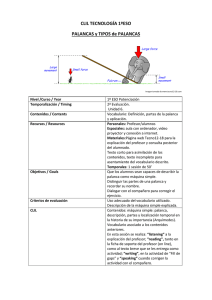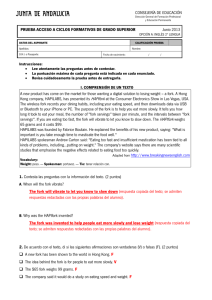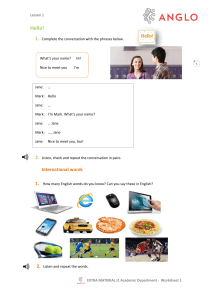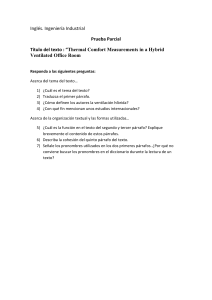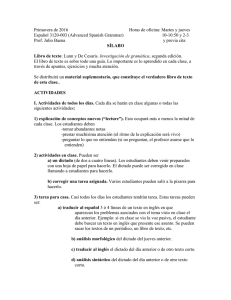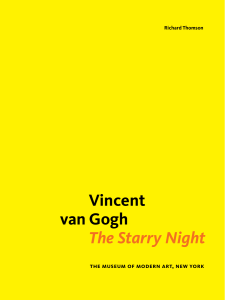examen final
Anuncio
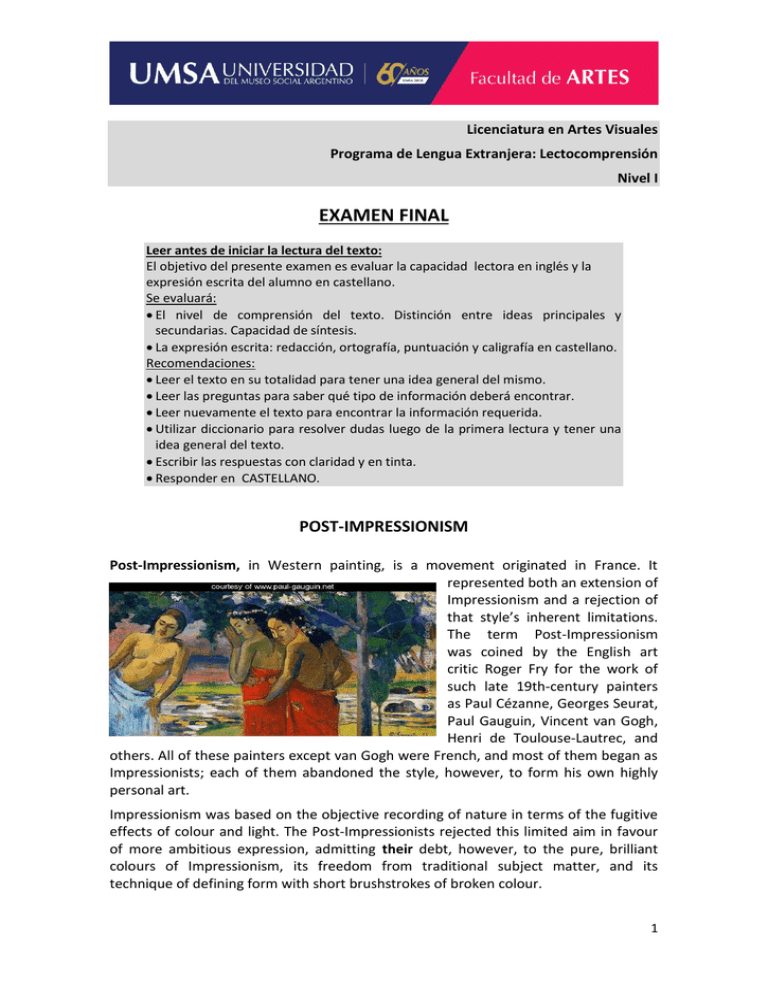
Licenciatura en Artes Visuales Programa de Lengua Extranjera: Lectocomprensión Nivel I EXAMEN FINAL Leer antes de iniciar la lectura del texto: El objetivo del presente examen es evaluar la capacidad lectora en inglés y la expresión escrita del alumno en castellano. Se evaluará: El nivel de comprensión del texto. Distinción entre ideas principales y secundarias. Capacidad de síntesis. La expresión escrita: redacción, ortografía, puntuación y caligrafía en castellano. Recomendaciones: Leer el texto en su totalidad para tener una idea general del mismo. Leer las preguntas para saber qué tipo de información deberá encontrar. Leer nuevamente el texto para encontrar la información requerida. Utilizar diccionario para resolver dudas luego de la primera lectura y tener una idea general del texto. Escribir las respuestas con claridad y en tinta. Responder en CASTELLANO. POST-IMPRESSIONISM Post-Impressionism, in Western painting, is a movement originated in France. It represented both an extension of Impressionism and a rejection of that style’s inherent limitations. The term Post-Impressionism was coined by the English art critic Roger Fry for the work of such late 19th-century painters as Paul Cézanne, Georges Seurat, Paul Gauguin, Vincent van Gogh, Henri de Toulouse-Lautrec, and others. All of these painters except van Gogh were French, and most of them began as Impressionists; each of them abandoned the style, however, to form his own highly personal art. Impressionism was based on the objective recording of nature in terms of the fugitive effects of colour and light. The Post-Impressionists rejected this limited aim in favour of more ambitious expression, admitting their debt, however, to the pure, brilliant colours of Impressionism, its freedom from traditional subject matter, and its technique of defining form with short brushstrokes of broken colour. 1 After a phase of uneasy dissension among the Impressionists, Paul Cézanne withdrew from the movement in 1878 in order “to make of Impressionism something solid and durable like the art of the museums.” In contrast to the passing show depicted by the Impressionists, his approach imbued landscape and still life with a monumental permanence and coherence. The Post-Impressionists often exhibited together, but, unlike the Impressionists, they painted mainly alone. Cézanne painted in isolation at Aix-en-Provence in southern France; his solitude was matched by that of Paul Gauguin, who in 1891 took up residence in Tahiti, and of van Gogh, who painted in the countryside at Arles. Both Gauguin and van Gogh rejected the indifferent objectivity of Impressionism in favour of a more personal, spiritual expression. After exhibiting with the Impressionists in 1886, Gauguin renounced “the abominable error of naturalism.” He sought a simpler truth and purer aesthetic in art; turning away from the sophisticated, urban art world of Paris, he instead looked for inspiration in rural communities with more traditional values. Copying the pure, flat colour, heavy outline, and decorative quality of medieval stained glass and manuscript illumination, he explored the expressive potential of pure colour and line, Gauguin especially using exotic and sensuous colour harmonies to create poetic images of the Tahitians among whom he would eventually live. Arriving in Paris in 1886, the Dutch painter van Gogh quickly adapted Impressionist techniques and colour to express his acutely felt emotions. He transformed the contrasting short brushstrokes of Impressionism into curving, vibrant lines of colour, exaggerated even beyond Impressionist brilliance, that convey his emotionally charged and ecstatic responses to the natural landscape. ALUMNO REGULAR: 1. Responda las siguientes consignas en forma clara y precisa (4 puntos): 1.1. Subraye un verbo en voz pasiva. 1.2. Explique el surgimiento del Post impresionismo y sus representantes. 1.3. ¿Qué diferencias existen entre el impresionismo y el post impresionismo? 1.4. Indique si esta frase es verdadera o falsa, y justifique su respuesta: Los post impresionistas pintaban en grupo. 2. Resumen: Resuma, en no más de 150 palabras, las ideas principales del texto. Recuerde NO traducir sino redactar lo que ha comprendido, con coherencia y cohesión. Utilice un registro formal, sin abreviaturas y con letra clara. (6 puntos) ALUMNO LIBRE: 1. Responda las siguientes consignas en forma clara y precisa (4 puntos): 1.1. Explique el surgimiento del Post impresionismo y sus representantes. 2 1.2. ¿Qué ocurrió en 1878? 1.3. ¿Qué diferencias existen entre el impresionismo y el post impresionismo? 1.4. Indique si esta frase es verdadera o falsa, y justifique su respuesta: Los post impresionistas pintaban en grupo. Subraye en el texto lo que se le solicita (no olvide agregar el número correspondiente de la consigna) (2 puntos): 2.1. Un verbo en voz pasiva. 2.2. Un pronombre posesivo e indique su referente. 2.3. Una proposición adjetiva (Relative Clause). 2.4. Un gerundio. 2. Resumen: Resuma, en no más de 150 palabras, las ideas principales del texto. Recuerde NO traducir sino redactar lo que ha comprendido, con coherencia y cohesión. Utilice un registro formal, sin abreviaturas y con letra clara. (4 puntos) 3

